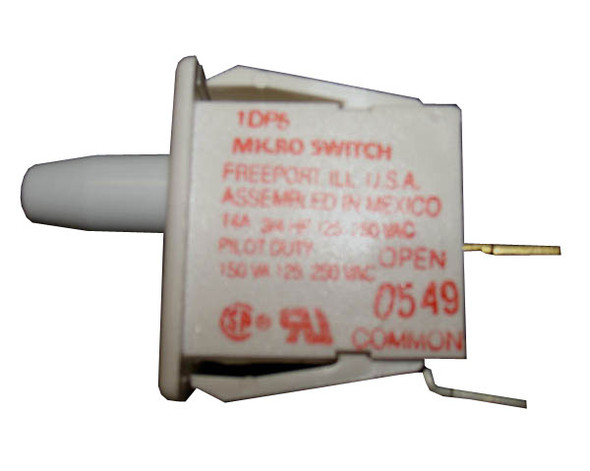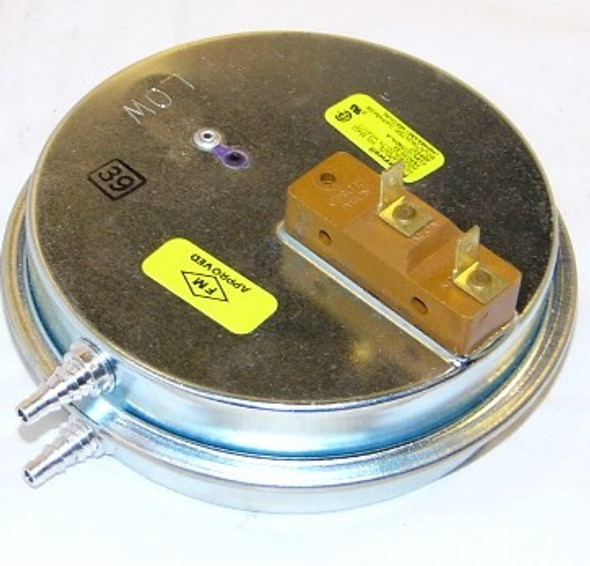Switches & Relays
- Product
- Qty in Cart
- Quantity
- Price
- Subtotal
-

Emerson Climate-White Rodgers 90-295Q FAN RELAY 240V (ENCLOSED)
Emerson Climate-White Rodgers
MSRP: $20.06Now: $15.20Emerson Climate-White Rodgers 90-295Q FAN RELAY 240V ENCLOSED FurnacePartSource.com Commitment Always Brand-New Genuine Parts In stock parts ship Same Business Day when ordered by 5PM ET No Minimum Order...MSRP: $20.06Now: $15.20 -

Amana-Goodman # 10727923 -.70"wc SPST 1/4" barb connection Pressure Switch
Amana/Goodman
MSRP: $82.53Now: $62.53Amana-Goodman # 10727923 -.70"wc SPST 1/4" barb connection Pressure Switch FurnacePartSource.com Commitment Item Typically Ships Within the Same Business Day Brand-New Genuine Parts - Everytime No Minimum Order RequirementsMSRP: $82.53Now: $62.53 -

Carrier HK06NB019 Pressure Switch
Carrier
MSRP: $170.84Now: $129.43Carrier HK06NB019 Pressure Switch FurnacePartSource.com Commitment Item Typically Ships Within the Same Business Day Brand-New Genuine Parts - Everytime No Minimum Order RequirementsMSRP: $170.84Now: $129.43 -

York S1-024-35271-000 (replacement for 024-35271-000) -.5"WC SPNO Close On Fall # Sw
York Controls
MSRP: $53.21Now: $40.31York S1-024-35271-000 -.5"WC SPNO Close On Fall # Sw This is identical to 024-35271-000 FurnacePartSource.com Commitment Item Typically Ships Within the Same Business Day Brand-New Genuine Parts - Everytime No Minimum Order RequirementsMSRP: $53.21Now: $40.31 -

100110001 AO SMITH .70"WC PRESSURE SWITCH
A.O. Smith
MSRP: $83.18Now: $63.01Type a description for this product here...MSRP: $83.18Now: $63.01 -

Xylem-Bell & Gossett 109426 (OBSOLETE) Z-3 ZONE RELAY
Xylem-Bell & Gossett
OBSOLETE with No Replacement: Xylem-Bell & Gossett 109426 Z-3 ZONE RELAY We're sorry--this item is no longer available. This part has been classified as obsolete with no replacement FurnacePartSource.com...Qty in Cart: 0Price:Subtotal: -

Danfoss # 060-5243 100/600# KPU6W SPDT Auto 1/4"F
Danfoss
MSRP: $113.75Now: $86.18Danfoss # 060-5243 100/600# KPU6W SPDT Auto 1/4"F FurnacePartSource.com Commitment Item Typically Ships Within the Same Business Day Brand-New Genuine Parts - Everytime No Minimum Order RequirementsMSRP: $113.75Now: $86.18 -

Nordyne # 632477R 0.70"WC SPST Pressure Switch
Nordyne
MSRP: $69.20Now: $52.43Nordyne # 632477R -0.70"WC SPST PRESSURE SWITCH FurnacePartSource.com Commitment Item Typically Ships Within the Same Business Day Brand-New Genuine Parts - Everytime No Minimum Order RequirementsMSRP: $69.20Now: $52.43 -
 MSRP: $50.11Now: $37.96
MSRP: $50.11Now: $37.96 -

Trane Pressure Switch; part #SWT1277
Trane
MSRP: $81.87Now: $62.03Trane® Pressure Switch; part #SWT1277; Limit Switch Open145F Close115f; Backed by a One Year Warranty. FurnacePartSource.com Commitment Item Typically Ships Within the Same Business Day Brand-New Genuine Parts - EverytimeNo Minimum Order...MSRP: $81.87Now: $62.03 -

Lennox Pressure Switch Part #24W98
Lennox
MSRP: $51.66Now: $39.14Lennox® Pressure Switch FurnacePartSource.com Commitment Item Typically Ships within the Same Business Day Brand-New Genuine Parts - EverytimeNo Minimum Order RequirementsMSRP: $51.66Now: $39.14 -

York Controls Pressure Switch Part# S1-024-35272-000
York Controls
MSRP: $52.68Now: $39.91York Controls® York Pressure Switch 0.54” on fall SPNOMSRP: $52.68Now: $39.91 -
 MSRP: $68.89Now: $52.19
MSRP: $68.89Now: $52.19 -


Texas Furnace (Consolidated Ind) 4026900 Pressure Switch .52"wc SPDT
Texas Furnace (Consolidated Ind)
MSRP: $138.55Now: $104.96Texas Furnace (Consolidated Ind) 4026900 Pressure Switch .52"wc SPDT FurnacePartSource.com Commitment Always Brand-New Genuine Parts In stock parts ship Same Business Day when ordered by 5PM ET No Minimum Order...MSRP: $138.55Now: $104.96 -

Heil QuakerVent Pressure Switch Part #609537
Heil Quaker
MSRP: $147.16Now: $111.49Heil Quaker® VENT PRESSURE SWITCH Heil / Sears Kenmore unitsMSRP: $147.16Now: $111.49 -

York Controls Pressure Switch Part #S1-024-25006-710
York Controls
MSRP: $117.13Now: $88.74York Controls® .65"wc PRESSURE SWITCHMSRP: $117.13Now: $88.74 -

York Controls Pressure Switch Part #S1-026-32266-001
York Controls
MSRP: $228.44Now: $173.06York Controls® PRESSURE SWITCH, .60"WCMSRP: $228.44Now: $173.06 -

York Controls Roll Out Switch Part #S1-025-27747-012
York Controls
MSRP: $96.94Now: $73.44York Controls® 260F Rollout Switch Manual CloseMSRP: $96.94Now: $73.44 -

Amana/Goodman Pressure Switch Part #20197312
Amana/Goodman
MSRP: $44.30Now: $33.56Amana/Goodman Pressure Switch Part #20197312 FurnacePartSource.com Commitment Item Typically Ships Within the Same Business Day Brand-New Genuine Parts - Everytime No Minimum Order RequirementsMSRP: $44.30Now: $33.56 -
 MSRP: $91.90Now: $70.98Qty in Cart: 0Price:MSRP: $91.90Now: $70.98Subtotal:
MSRP: $91.90Now: $70.98Qty in Cart: 0Price:MSRP: $91.90Now: $70.98Subtotal:
